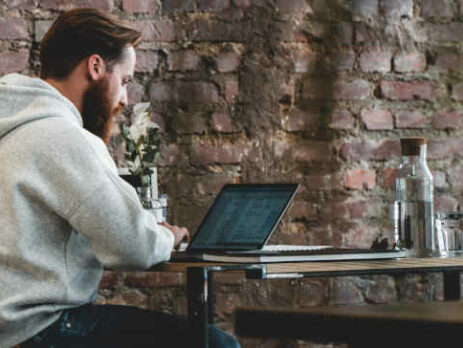20 Things Every Designer Should Know About Working Remotely in 2020
2020 was a landmark year in many ways, including how it transformed the way many of us do our jobs. In many cases, people whose jobs were moved to working remotely in 2020 are looking at a permanent change rather than a short-term one. Companies like saving money on rent for huge brick and mortar buildings and the majority of workers who began working remotely in 2020 want to keep it that way.
Working remotely as a designer is a different can of worms. While the design part of the job does lend itself to remote working since most design tools are now computer-based, user research and teamworking to brainstorm are slightly different when working remotely. Luckily, designers are just the type of people to adjust to new situations like this one and have come up with some very effective ideas to make the new reality work very much like the old one.
In fact, remote design work can follow in the footsteps of other industries who saw a marked increase in productivity when they made the jump to remote work. Although many managers worry that employees will be too tempted by the internet’s many distractions if they aren’t in the office, that has overwhelmingly not been the case. With the right team structure and clear rules for communicating and scheduling remote meetings, working remotely as a designer can be more streamlined than doing so from a traditional office environment.
Even in that traditional office environment, managers and other senior talent have been concerned with receiving concrete deliverables like wireframes and prototypes from their designers to make sure they’re being productive. That can become even more valuable for management when it comes to remote design work. There are a few ways that designers can demonstrate their productivity in other ways that will keep them from wasting time making premature prototypes and other deliverables.
Keeping a schedule is one thing that newcomers to remote work have trouble adjusting to. The self-motivation to start on time and working with team members in different time zones can both affect the ease with which remote workers keep a regular schedule. Of course, some remote working jobs have much more flexible hours.
In addition to a wider variety of jobs, remote work has a multitude of benefits. If you can maintain the right work-life balance it’s even better than working in an office. It might not be for everyone, but working with a partly remote team is more possible than ever thanks to new video conferencing and messaging platforms.
Whether you’re working remotely as a designer suddenly after a decision by the company or you’re thinking about making the jump for yourself, the 20 tips in this article should help you get a clear idea of what remote design work entails and how to make the most of this relatively new structure. Read on for the full rundown on remote design work in 2020.
The State of Remote Design Work: How Much Design Work Is Remote?
In 2019, some studies found that as much as 14% of design work positions were fully remote. That number has no doubt increased with the tumult of 2020, but it’s hard to say definitively how much remote design work will stay that way once the dust has settled. Generally speaking, we can all look forward to more remote work. That might be partial in some cases and only certain team members depending on how the structure of a given business works, but remote work is certainly growing in frequency and importance across the working sector.
Distributed teams are becoming more and more popular in many professions but there’s no consensus on which is the most effective. Most of the time, it’s up to the business and the wishes of the individual workers to decide how they want to organize themselves. Some are half remote or more while other design teams have constructed completely remote teams that are working all around the world.

20 Things Every Designer Should Know About Working Remotely
Working remotely as a designer has its own special challenges. Read through these 20 tips so you know what to be aware of and how to keep your creativity and productivity burning when you work remotely.
1- Staying Connected is Easier Than Ever
It’s probably not a news flash to anyone that our world, professional and not, is more connected than it’s ever been before. When it comes to remote work, connectivity is a double-edged sword. It’s easy to stay logged in all the time, especially if part of the team is in a different time zone. Even if it becomes commonplace to have chat exchanges at all hours, it’s wise to put a limit on when business can be conducted. Otherwise, everyone runs the risk of burning out.
2- Stakeholders Might Hesitate
Just as designers are having to figure out the new reality of remote work, so are the stakeholders who employ them. In many cases, they’re worried about productivity, even though studies showed work-from-home employment structures increased productivity levels as early as 2013. In any case, be ready for your stakeholders to approach remote work with some hesitancy and stay in near-constant contact while the company adjusts.
3- You Should Still Have An Office
Whether you work from home or a cafe, it’s important to have a dedicated workspace to help keep your work-life balance in order. It’s doubly important at home because once your house or apartment becomes your workplace it can very easily start to feel like you’re always on the clock. Invest in a desk if you don’t have one yet and have space and try to avoid working from your bed or couch. Even if they’re super comfortable, it can ruin your ability to relax there once work is over.
4- Communication is Key
Design work already requires a high level of communication between the creatives, stakeholders, and users. Get ready for it to go underneath a microscope once you start working remotely because any small hiccup in communication is going to have outsized effects when everyone isn’t in the same office building together anymore. You’ll have to be online more often but make sure you set a definite time limit where you won’t be answering emails or messages so you’re not effectively on the clock 24/7.
5- Procrastination Will Kill You
If you need the pressure of a deadline to motivate you through the end of a project, you might be tempted to let work stack up even more when your office is just in the next room all the time. Not only will this affect how many deliverables you can show stakeholders, but it will create a situation where you’re burning the midnight oil just to finish something you had ample time to do. Not only will this ruin your work-life balance, but it will undermine your reliability for the rest of your team. Keep a close watch on that calendar and don’t get too lax even if you’re working from home.
6- You Have Some Explainin’ To Do
Just like you need to do for case studies and deliverables, you have to take the time to explain your design thinking to stakeholders and other members of the team. This might seem obvious, but designers should still be mindful of it when they start working remotely. It’s really challenging with clients and stakeholders who build up trust with a certain designer because they’ll be tempted to cut the explanation short or out entirely to save themselves some time. Assert yourself and explain your designs and design thinking to make sure everything is done to your own standards.
7- Rethink Your Research Plans
UX and UI design rely on feedback and research like A/B testing to get information on new iterations of a product. Working remotely as a designer, you won’t be able to get people together physically as easily anymore. That’s great because you can be a bit more flexible, but you’ll miss out on some nonverbal cues from the users if you’re interviewing them via computer. Many designers have turned to automated user research, which is a huge time saver but doesn’t necessarily return the best results every time. Moderated remote research is different in some ways, but once you get the hang of it it’s much the same as traditional UX research methods.
8- You Can Include Clients More
This will depend on the particular client, but if the creative team is communicating and brainstorming via video conference, that means you can include the client more often than you can with in-person meetings. It also enables you to exchange information with the client much faster than you could before. Be careful with this new power, though, because extremely hands-on clients might abuse their ability to be included in the design process. Just like you have to do with your schedule, you have to set clear limits about how much the client needs to be involved. Center their convenience if they’re especially unaware.
9- Structure Your Day
Again, this will be even more important if part of the team is working in a different time zone, but organizing your time is the best way to make sure everything gets done. It will also help you decide when to clock out for the day and preserve that ever-important work-life balance.
Many designers like to start their day differently. If you’re a morning person, you can schedule your calls, meetings, and important work right away. Otherwise, you can leave it for later in the morning or after lunch. One of the best advantages of remote design work is that you can set your own schedule, just make sure you do so or you might be in the weeds pretty quickly.
10- Learn New Skills
You should always stay up to date on the latest design thinking, but if you’re going to be working remotely you also need to learn new platforms for video conferencing, calls, and sharing deliverables. Take time to learn how to make a video chat engaging and you’ll outshine the competition in no time. Since working remotely is becoming so commonplace, there are plenty of online seminars for designers to learn the new tricks of the trade. Keep an eye out for such opportunities to be the best remote designer you can be.
11- The Team Has to Generalize
Not everyone is going to be available all the time, provided people are keeping their set hours as stated. That means everyone will have to have a more generalized set of skills to make sure they can solve problems quickly if they should arrive when the resident expert isn’t online. Of course, these can be temporary fixes, but the team should be able to at least do that much to avert catastrophe. Learning general skills is fairly simple, though. Set up group meetings where people can explain their specialties for a nice team-building exercise.
12- Keep the Client Happy
Of course, you need to keep your clients happy, but when you’re working remotely you must remember to stay in touch with them so you can build a working relationship. That’s the best way to get referrals for more work and it will boost the reviews of your design skill and the company overall.
13- Dress For the Job You Want
Though it’s tempting to stay in your pajamas all day or sit through a conference call with no pants on, it will help you get into the working mindset if you keep dressing like you’re going to the office. Maybe you can skip the suit, but wearing a normal outfit instead of pajamas or a robe will do wonders. It also helps you switch out of work mode at the end of the day when you do get back into your more casual wear.
14- Stay Creative
Brainstorming and spitballing are both going to have to go online when you do. Make sure you keep up a steady diet of design thinking books and non-design sources of inspiration so your design work can stay on the cutting edge. It’s probably wisest to pencil in a half-hour each day just to take in some inspirational material to keep the creative juices flowing.
15- Fight Off Isolation
Even though you should have a set workspace, try to get out of your house or apartment every now and then for a change of scenery. When you spend all your time in your living quarters, isolation can sneak up on you. Video conferencing is convenient, but it doesn’t replace in-person human interaction. If you’re able to, meet with coworkers face to face occasionally even if it’s just to hang out.
16- The User Might Be Remote, Too
It’s not just designers who have gone remote. Remember that many users will have this reality and it can lead to new pain points that weren’t necessarily there before 2020. Your new designs should function for people on the go and possibly traveling to new places because they have the flexibility to do so.
17- Templates Are Your New Friends
Streamline your video conferences, emails, and other digital communication with templates. This is especially useful if you find yourself doing the same kind of tasks regularly. People who work in traditional offices can also use this tip, but for remote design work where all communication has to be done on the computer and by phone, having templates for regular tasks can save tons of time.
18- Invest in Reliable Internet
For many people, reliable internet connectivity was achieved many years ago. However, if you’re the traveling type or prefer to work outside the house, you need to invest in a source of internet that you can rely on if the coffeeshop or hostel where you’re staying has shoddy internet access. That could be a personal router or it could be a phone plan that has plenty of data, allows hot-spotting, and always has a signal.
19- Don’t Skip Steps
Design is iterative and it’s tempting to skip some of the steps if your client or stakeholders have faith in you to deliver a great final product. However, this can cause you to miss some user feedback or leave something out. Keep doing things just like you did in the traditional office so you can keep producing the same level of work.
20- Back Everything Up
All of your work product is going to be digital if you’re working remotely. Invest in reliable cloud storage and back up everything with a solid-state hard drive so you never lose anything even if a computer breaks on you. You’ll be happy to have all that information when you put together a case study or want to show off your portfolio to a potential client.

Conclusion:
Many industries have seen increases in remote work positions in 2020 and design is no different. Staying on top of communication and learning new software might sound overwhelming, but the learning curve is actually very small. Whether your company has decided you’ll be remote or you’re interested in doing so yourself, take these 20 pieces of advice into account to make sure your design work stays cutting edge and clients keep coming back for more.












